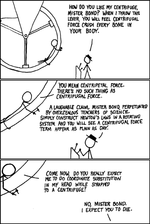And, if we didn't take it for granted, gravity might be called "spooky action at a distance".
Actually, that fery idea freaked out Newton, who although he described how gravity works, confessed himself baffled as to what this mysterious force was that could act, well, spookily at a distance. Although of course he did not use that term, which Einstein later used in a different context.
’
Einstein showed that gravity was a fictitious force, and that gravitational attraction is explained by bodies moving in curved spacetime. The real “spooky action at a distance” in quantum mechanics is nothing like gravity, but even so you can’t use spooky action at a distance to send messages faster than c.
I don't go along with the notion of curved spacetime. It leaves us with the question: "What causes spacetime to curve?", and what answer do we have other than some "force"?
Mass causes spacetime to curve - or at least, to behave mathematically as though it were curved.
Modelling spacetime as a multidimensional stack of fields, in which particles represent probability maxima in a given field, is mind-blowingly counterintuitive, but gives astonishingly accurate predictions that cannot be matched by any other approach, so for non-gravitational questions, Quantum Field Theory is the only game in town, despite being utterly horrifying philosophically. In such a model, all forces are due to the exchange of gauge bosons with integer spin, with those bosons being probability maxima that propagate in their respective fields at a rate of
c.
As we have detected these bosons for three of the four known fundamental forces (photons, W-bosons, and gluons, for the electromagnetic, weak, and strong forces respectively), it seems reasonable to hypothesise that the remaining force - gravity - has a similar mechanism.
The hypothetical mass of the graviton is somewhere between minuscule and zero, and they only interact in proportion to mass, so detecting them is a major undertaking - if they exist, you would need a detector the size of a very large planet, in close orbit around a supermassive object (a neutron star or a black hole), to stand a serious chance of seeing one, and even then you would need to run the detector for years, maybe decades.
The upper limit of their hypothetical rest-mass is set by our observation of the distances over which gravity operates, and the observation that it propagates as close to
c as we can measure - this limit was theorised in the 1970s to be around 10
−29eV, and has since been refined to 6x10
-32eV - and that’s the absolute upper limit of the range of possible masses for this particle.
It’s possible that the unexplained super large scale phenomena provisionally tagged as ‘dark matter’ and ‘dark energy’ are due to even weaker, and even longer range, forces. However as these are only detectable at galactic scales, their implied bosons are going to be even harder to pin down than the graviton.
The problem is that gravity is utterly pathetic. The electromagnetic force generated by a tiny fridge magnet is easily able to overwhelm the gravity generated by an entire planet; The gravity generated by sub-planetary masses is within a bee’s dick of fuck all, making it a total bastard to even detect in a lab, much less work with to any degree of precision. We only notice gravity at all because it acts at astonishingly long ranges - you don’t need to move that fridge magnet far from the fridge door, for the gravity of the Earth (centred some 6,400km away) to exceed the electromagnetic force from a steel substrate a mere few cm away.
TL; DR - Einstein was probably wrong, for a given value of ‘wrong’, which is to say, he improved on Newton, who was also wrong, and both men produced models of reality that are both easy to work with, and extremely accurate at the scales which were relevant to their observations.
Everything in physics is wrong; The trick is to be wrong to a sufficiently tiny degree as to not get caught out. So far, only Quantum Mechanics and General Relativity achieve this level of non-disagreement with observed reality. The kicker being that they disagree
with each other. One or both must therefore be wrong. Probably both, based on the history of science; But it’s going to take some seriously impressive observations to demonstrate situations where errors in either can be confirmed and measured.
Still TL; Still DR - Einstein was wrong, but not as wrong as pretty much everyone else in the history of science, so give the man a break.

